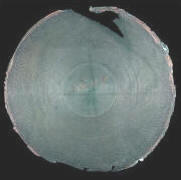Alexander Graham Bell's Audio Recordings Heard 130 Years Later |
|
1 | 2 | 3 | 4 | 5 | 6 | 7 | 8 | 9 | 10 | 11 | 12 | 13 | 14 | 15 | 16 | 17 | 18 | 19 | 20 | 21 | 22 | 23 | 24 | 25 | 26 | 27 | 28 | 29 | 30 | 31 | 32 | 33 | 34 | 35 | 36 | 37
What took so long for work to begin on this and other archived recordings? Mainly it was the lack of a process for recovering the embedded data without risking damage to or destruction of the often fragile media. Berkeley Lab's approach creates a high-resolution digital map of the disc or cylinder. This map is then processed to remove evidence of wear or damage (e.g., scratches and skips). Finally, software calculates the motion of a stylus moving through the disc or cylinder's grooves, reproducing the audio content and producing a standard digital sound file. If you look closely at the glass disc, you can see jagged edges in the spiral pattern that represent the complex voice print that was extracted for processing. For more information, visit irene.lbl.gov. So, what message did Messrs. Bell, Bell, and Tainter consider important enough to place on this one-of-a-kind recording? Was it a secret password revealed only to 33rd-degree Freemasons, the key to accessing an underground treasure chamber containing the National Treasure, or maybe the code for President Chester Arthur's nuclear football? Maybe... but only if that word - yes, a single word - was "barometer." Barometer. That's it. All that work for "barometer." If you say that word on the phone or in an e-mail, know that the NSA's ECHELON program will be watching you forevermore. Listen to it here:
Bar-om-et-or. Bar-om-et-or. Bar-om-et-or. Bar-om-et-or. Bar-om-et-or. Bar-om-et-or.
Contact Information The National Museum of American History collects, preserves and displays American heritage in the areas of social, political, cultural, scientific and military history. To learn more about the museum, visit https://americanhistory.si.edu/. For Smithsonian information, the public may call (202) 633-1000, (202) 633-5285 (TTY).
Posted July 3, 2020 |
 "
"
